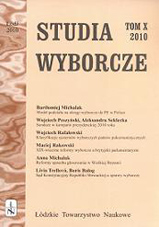Dlaczego obecny model podziału na okręgi wyborcze do Parlamentu Europejskiego w Polsce jest wadliwy i czy jest dla niego alternatywa?
WHY DOES THE CURRENT MODEL OF ELECTORAL CONSTITUENCIES FOR THE EUROPEAN PARLIAMENT IS FLAWED AND IF THERE IS AN ALTERNATIVE FOR IT?
Author(s): Bartłomiej Michalak Subject(s): Politics / Political Sciences
Published by: Łódzkie Towarzystwo Naukowe
Summary/Abstract: Parliamentary Extraordinary Commission of the Sejm currently works on the draft of the Electoral Code. The Code shall, as first assumed, reform the suboptimal solutions, improve poor ones and eliminate the clearly bad ones. But the main purpose of the ongoing codification is to guarantee stability of the electoral law for the future. Under current system, the distribution of seats among constituencies in elections to the European Parliament is closely associated with the division of seats among electoral committees which are mostly political parties. This means that the seats are not permanently assigned to the constituencies. The number of the seats depends on the division of votes among certain party lists. This differs from the traditional model of territorial representation, which is based on geographically defined constituencies. The current system is faulty and it does not follow any assumptions with the exception of the proportionality of electoral results. The main defects of this model there are: 1) disproportional distribution of seats among territorial constituencies, which in consequence causes violation of the principle of equality of electoral strength; 2) paradoxical allocation of seats, which may lead to weakening legitimization of the elections; 3) colourable fulfillment of the “higher turnout in the region = more seats in the constituency” demand; 4) no warranty that all districts will always receive seats; 5) complicating the elections, which may lead to a conviction that the electoral process is unclear. Alternative solutions are free from the mentioned problems. What is more – they have some additional desirable features. In the article, the author describes in detail the model of traditional, geographically defined constituencies. This includes five regional districts where seats are ascribed to the districts permanently in a different manner that it is today. Another solution is when the entire nation is one, multimember constituency. In author's opinion each of these alternatives should be considered by decision-makers if a much better law is their goal.
Journal: Studia Wyborcze
- Issue Year: 2010
- Issue No: 10
- Page Range: 7-26
- Page Count: 20
- Language: Polish

